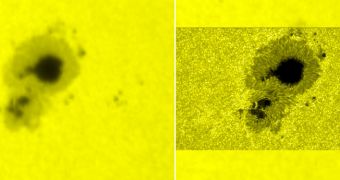About 5 days ago, the Japan Aerospace Exploration Agency (JAXA) celebrated the launch of its Hinode solar observatory, a 5-year-old telescope that has provided solar physicists with a new understanding of the Sun and its characteristics.
As evidenced by the December 6, 2006, image attached to this article, the observatory exceeded the capabilities of similar instruments straight off the bat. The image to the left is taken by the NASA Solar Heliospheric Observatory (SOHO), while the one to the right was captured by Hinode.
Both telescopes images the same formation on the surface of the Sun, and the difference in the amount of visible details is obvious. The high-resolution capabilities the Japanese observatory displays helped solar physicists understand various types of structures emerging on the surface of the Sun.
Both the United States and United Kingdom collaborated on the mission, which launched to space aboard an M-V-7 rocket, from the Uchinoura Space Center, in Japan. Takeoff occurred on September 22, 2006, at 21:36 UTC (06:36 JST September 23).
On October 28, Hinode opened its eyes for the first time, capturing its first views of the Sun. Its Extreme Ultraviolet Imaging Spectrometer (EIS) instrument had finally started collecting spectroscopic images. The other instruments, XRT and SOT, were already operational since October 23 and October 25.
“One of the most notable contributions Hinode has made is to produce high resolution observations of what the magnetic fields look like on the Sun,” NASA's Marshall Space Flight Center astrophysicist and X-Ray Telescope (XRT) co-investigator Jonathan Cirtain explains.
This instrument is perfectly capable of identifying coronal holes, a series of areas on the surface of the Sun that exhibit lower magnetism than their surroundings. Hinode was able to identify these locations as soon as it was brought online.
On the other hand, the EIS instrument was able to show how the corona is heated so much more than the actual surface of the Sun. “A spectrograph can help you get really precise,” NASA Goddard Space Flight Center expert Therese Kucera explains.
“With imagers alone you see a broad range of light mixed together, but the spectrograph can zero in on a narrow temperature band,” adds the scientist, who worked extensively with Hinode data.
At this point, the NASA Solar Dynamics Observatory and upcoming “missions like NASA Interface Region Imaging Spectrograph (IRIS) and a Japanese solar mission currently designated simply Solar-C will continue to build on these observations,” a NASA press release says.
These spacecraft will be capable of “teasing apart the way the constantly twisting and moving magnetic fields of the sun sends energy out to the corona, to Earth's magnetosphere, and ultimately to all corners of the solar system,” the statement concludes.

 14 DAY TRIAL //
14 DAY TRIAL //